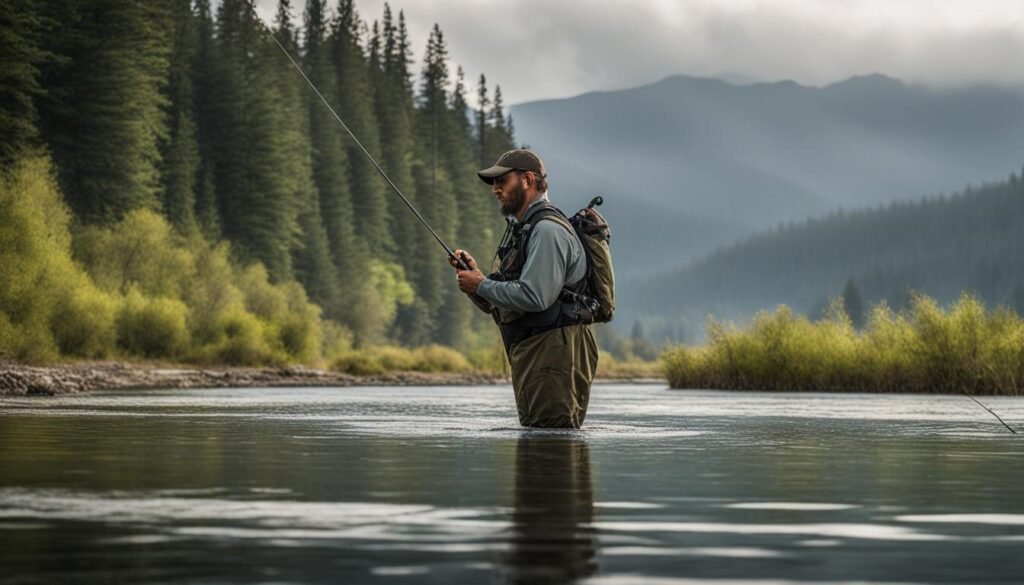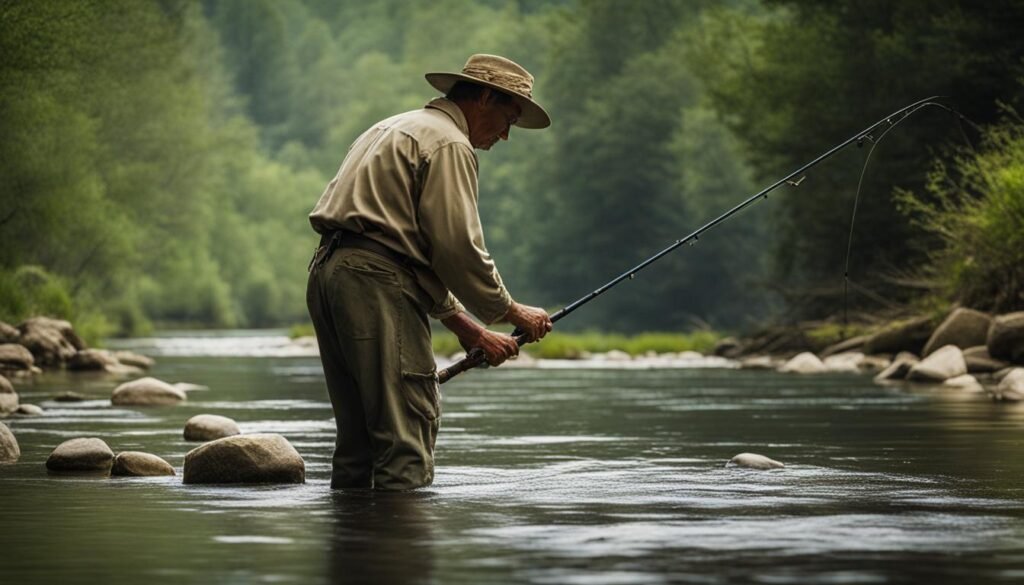Are you an avid fly angler looking to improve your casting technique? Look no further than the roll cast! This basic casting technique is a must-learn for fly anglers of all skill levels. Whether you’re facing obstacles on your back cast or fishing in tight quarters, the roll cast is your go-to move.
So, what exactly is a roll cast? It’s a casting technique that relies on the tension between your fly line and the water’s surface to propel the line forward in a tight loop. The best part? You can eliminate the need for a back cast altogether.
How to Roll Cast – A Step-by-Step Guide
Roll casting is a fundamental technique for fly anglers, and mastering it can greatly improve your casting skills. Here is a step-by-step guide to help you execute a successful roll cast:
- Hold your hand high: Start by holding your hand high, parallel with your ear. This position ensures the correct angles for the cast and sets you up for success.
- Look where you want to cast: Before making your cast, look where you want your fly to land. This will help you maintain accuracy and target your desired spot.
- Push the rod forward: Push the rod forward in a fluid motion, using your forearm and wrist. The key is to make a smooth and controlled movement, allowing the line to roll out in front of you.
- Snap the wrist: As you push the rod forward, snap your wrist at the end of the cast. This adds power to the cast and helps propel the line forward in a tight loop.
- Hold the rod high: After the cast, hold the rod high to prevent the line from unrolling on the water. This ensures that your line stays taut and ready for the next cast.
Tips for Perfecting Your Roll Cast Technique
- Practice in different conditions: Try roll casting in various environments and situations to get a feel for how it performs. Experiment with different rod lengths and weights to find what works best for you.
- Focus on your timing: Timing is crucial in roll casting. Practice the fluid motion of pushing the rod forward and snapping your wrist at the right moment. This will help you achieve a smooth and accurate cast.
- Use your whole body: While the wrist plays an important role in the roll cast, don’t forget to engage your entire body. Use your forearm, shoulder, and even your legs to generate power and control throughout the cast.
- Seek expert guidance: If you’re struggling to master the roll cast, consider hiring a casting instructor or attending a fly fishing clinic. A knowledgeable expert can provide personalized guidance and help you overcome any challenges you may face.
The Benefits of Roll Casting
Roll casting offers numerous advantages for fly anglers in various fishing scenarios. Whether you’re fishing in tight quarters or dealing with obstacles like branches or snags, the roll cast can help you overcome these challenges and improve your overall fishing experience.
- Accurate and precise casting: Roll casting allows for accurate and precise placement of your fly in tight spaces where a full cast may not be possible. This technique enables you to present your fly exactly where you want it, increasing your chances of enticing a bite.
- No need for a back cast: In situations where there are obstacles behind you, such as overhanging branches or limited casting room, the roll cast eliminates the need for a back cast. This means you can effectively deliver your fly in areas that would otherwise be challenging to reach.
- Effective when fishing multiple flies: When fishing with multiple flies, the roll cast can save you time and effort. Instead of false casting, which can be time-consuming, you can simply roll cast to maintain control over your flies and achieve better presentation.
- Versatility with different fly types: Whether you’re using dry flies, nymphs, or streamers, the roll cast can accommodate various fly types. This versatility makes it a valuable technique that can be adapted to different fishing scenarios.

Mastering the Sidearm Roll Cast
In addition to the vertical roll cast, anglers can also master the sidearm roll cast, also known as the horizontal roll cast. The sidearm roll cast is particularly useful when fishing in areas with low-hanging brush or when dealing with strong headwinds. By executing a sidearm roll cast, anglers can achieve longer casts and improved accuracy.
Technique for Sidearm Roll Cast
To perform a sidearm roll cast, anglers should follow these steps:
- Hold the rod in the sidearm position, with the tip slightly behind the body.
- Make a smooth back and forth motion parallel to the water’s surface.
- Allow the line to travel close to the water, easily going under obstacles.
By utilizing the sidearm roll cast technique, anglers can effectively cast their fly in tight spaces without the interference of low-hanging branches or strong headwinds. This casting method enables longer distances and improved accuracy, resulting in a more successful fishing experience.
When faced with challenging fishing conditions, such as tight spaces or strong headwinds, mastering the sidearm roll cast can be a game-changer. This casting technique allows anglers to adapt to their surroundings and overcome obstacles, leading to increased success on the water.
When to Use the Roll Cast
The roll cast is an essential technique that can be used in various fishing scenarios. Understanding when to use the roll cast can greatly improve your success on the water. Here are some situations where the roll cast is particularly useful:
Casting in Tight Quarters
When fishing in small streams or ponds with heavy foliage, there is often limited space for casting. The roll cast allows you to accurately place your flies in these tight quarters without the need for a back cast. By using the roll cast, you can avoid getting tangled in branches and other obstacles, increasing your chances of hooking a fish.
Dealing with Obstacles
If you are fishing in areas with low-hanging brush or facing strong headwinds, the roll cast can be a game-changer. By keeping the line close to the water and executing a horizontal cast, you can easily go under obstacles and achieve longer and more accurate casts. This technique allows you to navigate challenging conditions and present your fly effectively.
Fishing Upstream
When fishing upstream, the roll cast offers several advantages. It allows your fly to stay in the water for a longer period, providing a more natural presentation. By minimizing false casts and using the energy from the tension between the line and the water’s surface, you can make delicate presentations that are more likely to entice fish to strike. The roll cast is particularly effective when targeting spooky fish in clear water.
Tips for Improving Your Roll Cast
To enhance your roll cast technique and achieve better results on the water, consider the following tips:
Avoid crossing your fly line
During the roll cast, it’s important to avoid crossing your fly line to prevent tangling and ensure a smooth cast. Keep a close eye on the path of your line, making sure it doesn’t intersect with the rod or any other obstructions.
Maintain a smooth and fluid casting action
Aim for a smooth and fluid casting motion when performing the roll cast. Avoid any pauses or jerky movements that can disrupt the flow of the cast. A consistent and controlled motion will help generate the necessary energy for an effective roll cast.
Keep your stripping or “off” hand engaged
During the roll cast, it’s important to keep your stripping or “off” hand engaged to assist with line control and casting distance. By maintaining a firm grip on the line, you can help generate more power during the cast and achieve longer distances.
Practice regularly
Practice makes perfect, and this holds true for improving your roll cast technique. Take the time to practice the roll cast regularly, both on land and in real fishing scenarios. By building muscle memory and honing your skills, you’ll become more accurate and confident with your roll casting abilities.

Choosing the Right Fly Line for Roll Casting
When it comes to roll casting, selecting the appropriate fly line plays a crucial role in achieving success on the water. The best fly line for roll casting is a weight-forward line with a 20 or 30-foot belly. This type of line provides the necessary energy transfer during the roll cast, resulting in longer and more accurate casts.
Additionally, it is essential to choose a fly line that has the ability to shoot a substantial distance. This characteristic makes roll casting easier and more effective, allowing you to reach your desired fishing spot with ease. Investing in a quality roll casting line that is specifically designed for this technique can greatly enhance your casting performance.
Remember, the right fly line can make all the difference in the success of your roll cast. By choosing a weight-forward line with a 20 or 30-foot belly and the ability to shoot a substantial distance, you’ll be well-equipped to execute smooth and precise roll casts, even in challenging fishing scenarios.
FAQ
What is a roll cast?
The roll cast is a basic casting technique used by fly anglers to cast their line in situations where there are obstacles or limited space. It relies on the tension between the fly line and the water’s surface to propel the line forward without the need for a back cast.
How do I perform a roll cast?
To perform a roll cast, anglers should hold their hand high, parallel to their ear, look where they want to cast, push the rod forward with a fluid motion, and snap the wrist. The rod should be held high at the end of the cast to prevent the line from unrolling on the water.
What are the benefits of roll casting?
Roll casting allows for accurate casting in tight quarters, eliminates the need for a back cast in obstructed areas, and is effective when fishing multiple flies. It is a versatile technique that can be used with different types of flies and provides better presentation when fishing upstream.
How can I improve my roll cast technique?
To improve your roll cast technique, you should avoid crossing your fly line, maintain a smooth and fluid casting action, keep your stripping hand engaged, and practice regularly in various fishing scenarios. Building muscle memory and accuracy is key to mastering the roll cast.
What type of fly line should I use for roll casting?
A weight forward line with a 20 or 30-foot belly is recommended for optimal roll casting performance. This type of fly line generates more energy during the cast and allows for longer and more accurate casts. Consider investing in a quality roll casting line designed specifically for this technique.

